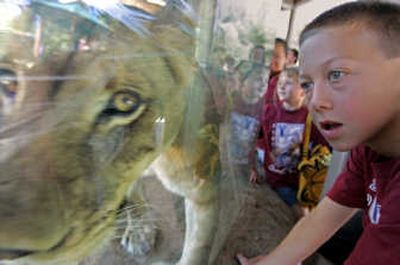Reversing tradition, Maasai sparing lions

SAN DIEGO – In their songs, the Maasai tribesmen of East Africa have long celebrated the killing of lions as a test of their manhood.
But now the Maasai that live in the Mbirikani Group Ranch in southeastern Kenya are trying to change their traditional antipathy toward the majestic-looking beasts.
To spread the message that the lion deserves to be saved, a Maasai troupe is spending the summer at the San Diego Zoo’s Wild Animal Park – dancing, singing and mingling with patrons near the area that is home to seven lions.
The Maasai are drawing flocks of tourists to their lectures – two of the dancers speak English – and their performances at a grassy area near the hot-air balloon ride adjacent to Lion Camp.
“We have decided as a community to put down our spears and try to save the lion,” said Noah Nchona Ntiata, the troupe’s elder.
Under an agreement with the Maasailand Preservation Trust, the Maasai will accept compensation when a lion kills one of their livestock rather than hunting and killing the predator.
Using donations and eco-tourism income, the trust pays $80 for a donkey, $100 for a goat and $200 for a cow – this in a country where more than half the population lives on roughly $1 per day.
“From this day forward, on Mbirikani, the warrior and the lion are brothers,” a Maasai leader proclaimed in March.
In the three years of the compensation program, four lions have been killed on the Mbirikani Group Ranch, compared with 22 in the previous 18 months, according to Conservation International, a wildlife protection group based in Virginia.
The Switzerland-based World Conservation Union has listed the lion (Panthera leo) as “vulnerable” on its list of endangered species. In West Africa, the lion is listed as “regionally endangered.” The lion inhabits more than 30 African countries.
The number of lions has dwindled throughout Africa because of habitat reduction and hunting. Conservation International estimates that before European colonization in the 19th century, more than 1 million lions lived in Africa. The group puts the population now at 30,000, mostly in protected areas such as national parks.
Changing a tribal culture is not easy – for generations, only a Maasai who killed a lion could call himself a warrior.
The tribe’s dancing involves ritualized gestures symbolizing the lion hunt. The dancers’ high-pitched chanting speaks of the challenge of stalking and killing a lion with a spear or poison dart.
Still, the Maasai hope their lion-conservation program spreads to other group ranches and other parts of Africa. Paying ranchers for lost livestock makes more sense than merely declaring the lions off-limits for killing, said Wilson Nitoipo Sayioki, one of the seven Maasai men visiting the Wild Animal Park.
“The lions have the right to live and roam in their natural habitat,” said Sayioki, 25. “We’ve gone from conservation victims to conservation watchdogs.”
The Kenyan government has a stake in protecting the lion. Three-quarters of tourists to Kenya are wildlife or safari visitors, according to the nation’s ministry of tourism – and tourism is the nation’s largest source of foreign currency.